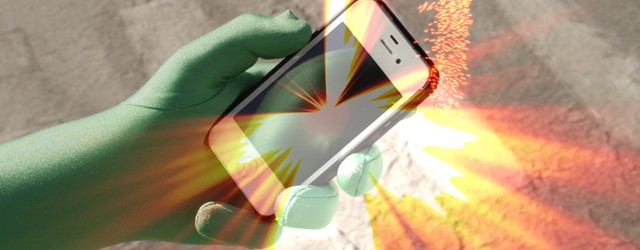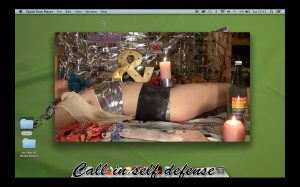Hito Steyerl looks tired. If it’s not right now –as we’re talking in London the day of her self-tilted survey exhibition opening at the ICA –then it’s a couple weeks later when she’s nodding off during the Lunch Bytes Medium:Format panel, after a hectic travel schedule and heavy subject in a talk with philosopher and friend Peter Osborne the previous night.
But long before this point, where the Berlin-based artist, writer and filmmaker strikes a fatigued figure wearing a tiger-themed hoodie and waiting the “seven minutes” for her laptop to boot, the world had already taken its toll. “Essentially I had a nervous breakdown”, she says frankly in her characteristic whisper, leaving me to worry about whether my Dictaphone will pick up on her soft-spoken voice and its reasoning for the eight-month delay of Steyerl’s latest film ‘Liquidity Inc.’ (2014). “I could have made it but it would have been a crap video, so I just decided not to make it. That means that I lost the budget, of course, which also means that it was delayed because then I had to basically do most of it on my own”.
Originally commissioned by Bergen Assembly but since self-funded, the film is a thirty-minute insight into the life of Jacob Wood –a cousin of editor, art critic and frequent collaborator Brian Kuan Wood –who began as a financial advisor before losing his job to the GEC and finding a future in martial arts. “[Brian] told me about it and I said, ‘this is amazing, we have to do something with Jacob’,” Steyerl says about the initial inspiration for the film, “I found a budget very quickly, it was also gone very quickly,” she adds laughing.

‘Liquidity Inc.’ is plugged in to the overwhelming and inescapable reality of hyper-connectivity. A CNN reporter explains the “short bursts of information” of a Google Glass prototype and a disguised Weather Underground anchor presents future forecasts across the double-edged “trade winds” marked on a geopolitical map; Steyerl finally capitulating to too much stimuli via chat box in a sea of chat boxes: “nervous breakdown cannot make Norway deadline”.
At one point, among the uncharacteristically au courant graphics (one of the few things a cash-poor Steyerl wasn’t forced to lift from YouTube tutorials and browser windows), ‘Liquidity Inc’ announces via text, “Weather is time. Weather is money. Weather is water”. Here is the space where climate change-meets-temporal shift, a reality where time is shattered, reduced to a deranged surge of fragmented micro-moments driven by technological progress. “The poor creature is thrown into a sort of wind-channel experience, constantly being tossed around”, Steyerl explains in a talk with Nina Power that night in relation to her evolving concept of “junktime” –also the title of an upcoming exhibition at Beirut’s Ashkal Alwan in April. “Duration cannot be sustained because people are exhausted. They cannot afford it anymore. They don’t have time. The time they have has to be artificially boosted or extended. You have to pretend you’re basically present on one online channel while you try to catch some sleep, but all the tab browsers are open at the same time.”
That’s what ‘Liquidity Inc.’ and, to a degree, Steyerl herself seems to embody. In naming the “multiplication of bodies” and “stand-ins”, an “exhaustion of extension” that effects both her physical body and body of work, there’s a fascination with this “form of matter” we all inhabit that can no longer withstand the demands of mass communication: “it’s a production mode that’s based on exhaustion of resources and basically of everything else as well. ”
I could imagine that making a film like ‘Liquidity Inc.’ would be overwhelming, also considering the all-consuming subject itself.
Hito Steyerl: Yes, I probably underestimated that, but also the process of making it was quite tough. I made it basically on the back of the budget of another film. I flew out to California for four days and we shot two films during that period. I was totally, totally jetlagged and then I started editing when I was on my way home, so that was the kind of time frame the movie was supposed to be produced in.

In terms of the ICA exhibition, it’s quite clear the link you’re making between all the films, especially this ‘art, war and business’ connection. There’s the part where you and Brian are talking and joking about selling your art…
HS: Selling art to weapons manufacturers in order to raise budget, yah [laughs]. I mean you have to imagine all of this is going on at the same time. I’m trying to write the lecture, which, is now called ‘Is the Museum a Battlefield?’ while I am dealing with all of these budget issues with the other works, it’s all happening in parallel.
I didn’t know whether it was farcical or you were just illustrating these connections of complicity in that lecture performance. Where you’re in the battlefield getting spammed, while inadvertently pointing your lens at the ammunition that has the same diameter of the sculpture at the exhibition your being spammed with.
HS: Yah [laughs]. Okay, I pushed facts a bit on that one but the point I tried to make is that at any point in the world you’re connected to spam. You’re also connected to art advertisement and all this kind of thing. They’re not separate realities. It’s all happening at the same time, on different layers.
These incidental elements feature quite heavily and you come away from it with this sense of helplessness.
HS: Helplessness or hopelessness?
Helplessness.
HS: Is this the case? I did this earlier work called ‘November’ and in there I make these claims about November being the state after October, a post-revolutionary state of stasis. It’s a state of post-revolution and things are falling apart, right? When people asked me and said, ‘oh, this is so hopeless’, I always replied, ‘well, after November there is going to be Spring’.
I said this since 2004 and Spring wouldn’t come, you know? [laughs] It’s just not coming for us. So yah, I think people are exhausted, waiting for it and fighting for it also. It’s not coming forth, it’s just not happening yet. So what are you going to do about it? I can’t fake it in my videos just to make people feel better about the situation.
Remember Karl Kraus during WW1? He said: ‘The situation is hopeless, but it’s not serious’. Or to rephrase it for today –only if it were serious, it would be hopeless. It would be helplessly hopeless but it’s not.
The survey of works covers such a short span of time that it feels like it’s identifying a point of terminal velocity, or complete collapse.
HS: Yes and no. Wide-ranging collapse did happen in fact, so it’s about rebooting a past crash. In fact most of the works are already about the reboot, not the crash. You fell apart and now there is a toe where your nose used to be, or a Twitter handle. You get used to it and get on with it. The twitter handle falls off, you replace it with some piece of scrap and take your kid to school, on a flotation device.
The crash was in fact a tsunami. Millions of people are living through this under much worse conditions right now. Forget about botox, just plonk some discarded piece of e-junk on your face. It’s so much more 2014 and you will not be face recognizable either! In the 90s we thought the cyborg was a planned device, engineered, artificial but still functional. Now I realise it comes about by just substituting missing limbs for scrap and rattling on –whatever works. People look more like Soyuz space capsules than iPhones these days.
I feel like this mentality of defeat is kind of converging with this macro outlook of Accelerationism.
HS: No, I think I’m absolutely doing the contrary of Acceleration. I’m really dealing with the point of impact, the crash, and the time after. Actually one of my previous works is called ‘After the Crash’, and it’s about cycles of Capitalism being constant cycles of acceleration, and then crash, and then regaining new dynamics from the crash itself, and then accelerating again, and crashing again.
This is what Capitalism feeds off, the moment of crash and collapse. It is thriving on ever-quicker successions of crisis, not breaking down. The more velocity and crash the more productive, from a Capitalist perspective. The only ones breaking down are people and some other life forms. With accelerated crisis and permanent crashing the rich get richer and the poor more sleepy, hungry and strained. I am not arguing for slowing down either. Rather for learning to ride out the waves or disappearing off-screen maybe, instead of mindlessly heading into yet another un-survivable crash.
But the crash also has quite baffling side effects. A lot of people I met recently who went through recent activism and brutal crackdown have, in my view, developed supernatural abilities, like the X-Men. They were beaten to pieces, or endured live fire and they come back glowing, and dashing, and fearless, and invincible; troubled by nightmares and PTSD, like Marvel superheroes. This is fascinating to me, a completely unforeseen side-effect of frequent crashing, of police batons coming down on people’s foreheads causing a mutation of minds, perhaps even an evolutionary quantum leap. Have you seen Captain America two? It’s a documentary!
So I don’t believe a bit in velocity, but in what happens after it’s taken away from you. Speed is not a political project. I think it’s a helpful conceptual tool for analysing the situation. A political project would be how to survive sudden deceleration and impact in a flamboyant and sustainable fashion.

I find myself suspended between the two ideas. There’s the one of the violence of the image and then this acceleration that comes from a specifically privileged perspective, where it’s easy to hide behind abstraction. But I feel like both approaches are reaching a similar conclusion. This exponential growth and endless progress, which is ultimately destructive, and there’s nothing we can do about it. I don’t see much hope in either.
HS: But we can do things about it. Create other connections for example. All these networks and networking can be done differently on many scales, on and offline. Just do basically something very similar to what exists but in non-proprietary ways and protect these from being swallowed up and exploited by quasi-info-monopolies. Also, undo connections. Cut. Interrupt. Shut down. Freeze. It’s all about montage again, this time on the level of infrastructure and social relations.
I was thinking about how everyone has a role to play, in some way. You can have those with extreme radical ideals, then others who can interpret and offer an access point for someone else to approach these problems more practically.
HS: There’s a political project in what I’m trying to do, it’s just not that obvious but I think it’s very important. So let’s assume we live in the process of ‘after the crash’, where basically everything is collapsing, and falling apart, and failing, and being exhausted. That also applies to time, space and people. People stop being able even to communicate with one another, precisely because there’s too much communication, technology, going on.
But I think if anything is going to happen, or going to change, then the most unlikely people in the most unlikely situations have to start communicating with one another, which they are not doing now. Many times I get asked, ‘why do you link all these implausible and improbable plots to one another?’ This is precisely why. Because I think that people in completely different, unlikely situations have to be even forced to acknowledge that they inhabit the same world, that they share the same problems.
There is too much communication going on, but not at all between those people who might need to talk to each other. So again, rerouting, rewiring connections and probably, actually argue and shout and get real, instead of endlessly reproducing consumerist conformism. It’s not rocket science. The tech is all there, take out a bit of comfort and use it differently.

When you talk about this ‘crash’ and this inability to communicate, I suppose ‘Liquidity Inc.’ really does reflect that, through your own life in parallel with making the film. Do you think that the fact that you did reach this point of ‘I can’t go any further with this’ is a reflection of that mass exhaustion?
HS: Yes of course. It happens in my life but also so many other lives. I think it’s one of the prevalent conditions of our times, no? It’s exhaustion, nervous disorders of all kinds, depression, anxiety. It’s as if your physical nerves are getting wired, but wrongly wired [laughs], to some networks, which you don’t even know if they’re run by Instagram or the NSA, or it’s the same anyway. But they really connect to your body. You are wired to dysfunction.
When you say you can’t provide the answers, it reminds me of the mock instructional video of ‘How Not to Be Seen’.
HS: But actually it’s a quite serious set of instructions because it just flows through with the dissolution of distinction between physical reality and the world of digital images. You are basically using the same tools to engage with both, or to act on to both. So yes, now people are using PhotoShop all the time to act upon reality, one should really try to own it and make it real.
What’s really unnerving about that video is when it starts with the resolution chart and then pans out to this huge pixel chart viewed from space. Is that real?
HS: It’s absolutely real. I couldn’t go there because it’s on an actual military base but you can see it from Google Earth. It’s actual.
Why is it on a military base?
HS: Well, of course most of them would be on military bases because the aerial photograph was used for mainly reconnaissance flights [laughs], or they were practising for military reconnaissance. They were calibrating their cameras.
I got the impression that it was part of this engulfing idea like in ‘Liquidity Inc.’, that the earth itself is captive to this thing.
HS: Yah, it’s been captured. Not all of it [laughs].
In what sense not all of it?
HS: It’s interesting because I tried so hard to get satellite imagery from that battlefield, which is the topic of ‘Is the Museum a Battlefield?’. Even though I was willing to pay good money for it there was no footage I could use, or no stock imagery I could use because the resolution in this area is too low. It’s about 30 metres per pixel.
So those areas of the world, which have no commercial value, in terms of satellite photography, they are being represented with a much lower resolution. They are captured as spam. But is also means one can hide in there to a certain extent.

That makes me think about the low resolution spots over North Korea where there are potentially concentration camps. It says one thing about the country concealing itself from global surveillance and another that no one cares enough to try and see.
HS: Yah, this is precisely the space of disappearance. It has both of these aspects. People can go missing inside but they can also be shielded from surveillance, reconnaissance surveillance.
Like the inspiration behind ‘How Not To Be Seen’, where people shield themselves behind these sheets of plastic and water, which is hopeful in some ways.
HS: Yes, totally, yes [laughs]. I was so inspired. I think for me this is really a hopeful example, that people could not only keep their good cheer under the shadow of the drone but also even read a book and educate themselves. It’s great.
In terms of commercial value, I was reading this article by an environmentalist about how on the coast of Nigeria the water is rising and slums are under threat. Meanwhile there’s a huge resort being built that is funded by and catering to those organisations that are largely responsible for global warming in the first place.
HS: Yes, of course [laughs]. ‘Waterworld’, it will be called. Upward class mobility will be measured in the number of floors in high rises. It already is if you look at many cities close to water.
And the economic term; liquidity meaning stable assets…
HS: It means that you are able to convert your assets quickly into cash, that’s what it means. If it’s real estate, it’s not as liquid as if it were, let’s say, art. Art is quite liquid. Cash is of course the most liquid of all assets.
It also makes me think about liquid itself; new economists thinking that rising sea levels are great because they’ll open up trade routes.
HS: Yes, of course [laughs]. There are always advantages. Siberia will do great. **















